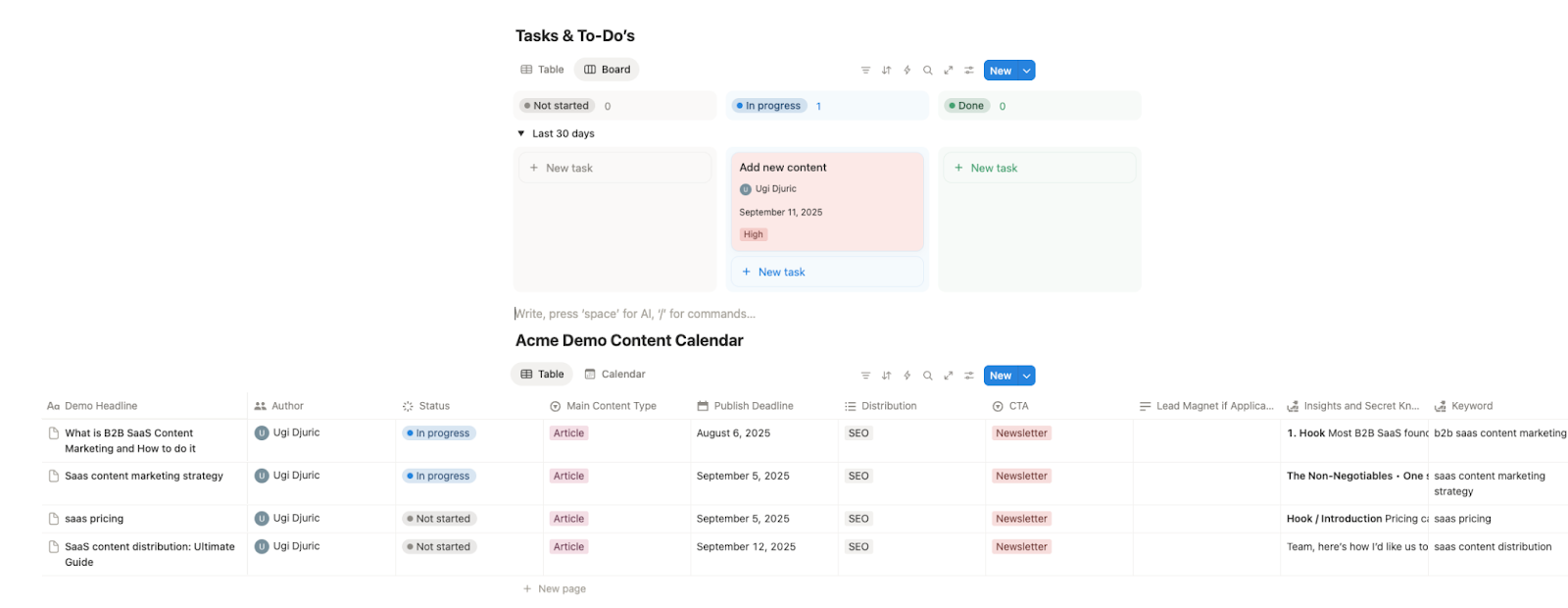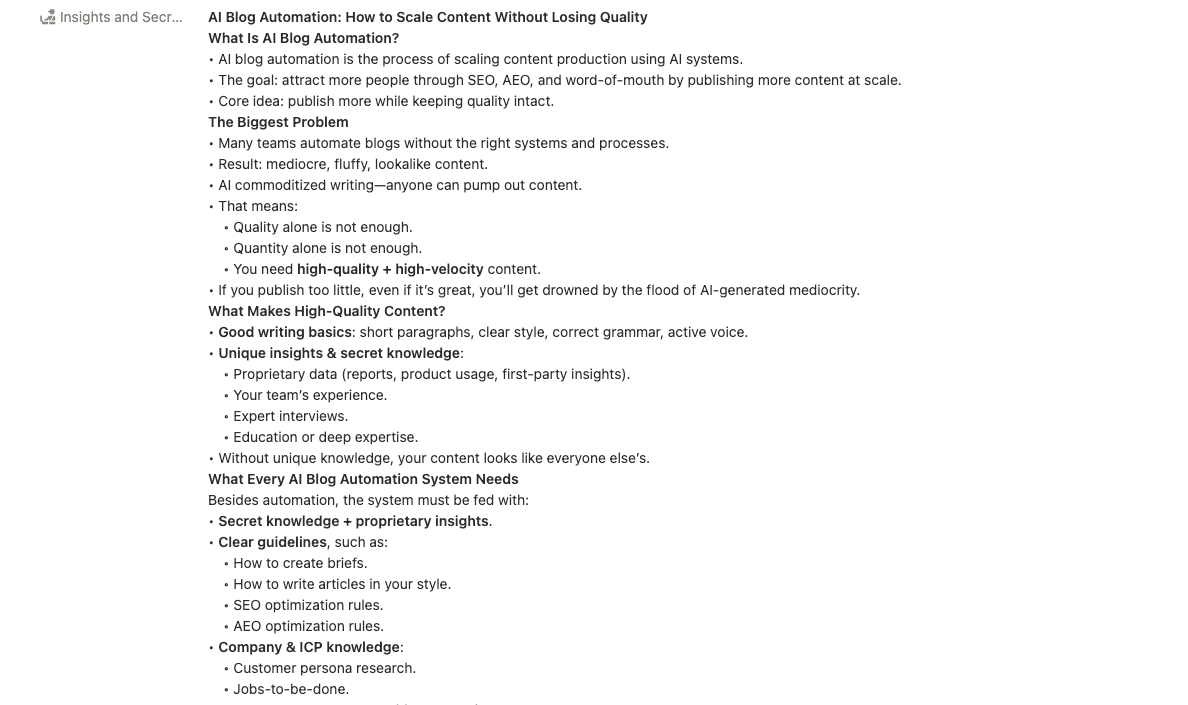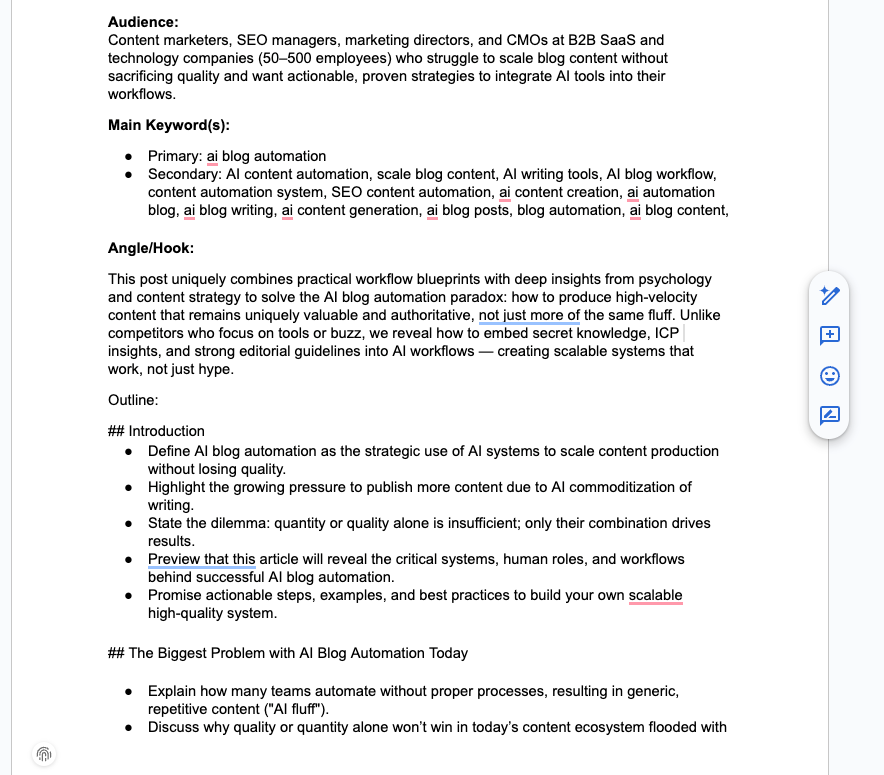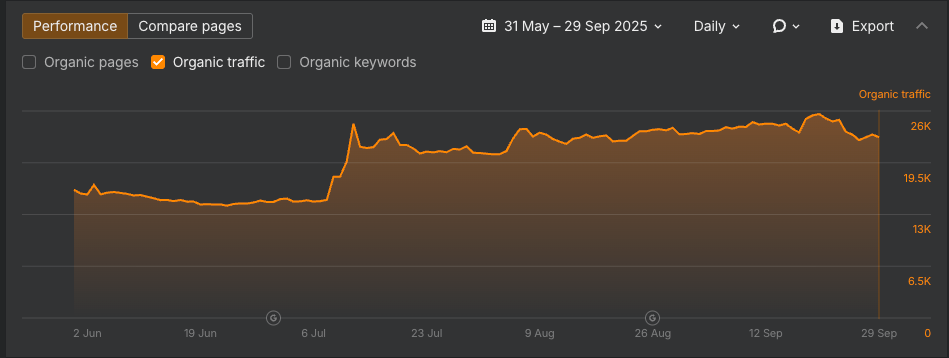A step-by-step breakdown of building an AI blog automation system that lets small teams publish 300+ quality articles/mo
Most people think AI blog automation means "let ChatGPT write everything." Those people are drowning in their own mediocrity.
The internet doesn't need more content. It needs less bad content and more stuff worth reading.
The problem is that your competitors are publishing faster than ever, and if you're still manually cranking out five posts a month, as if it were 2019, you're already losing.
The old playbook is dead. Quality alone won't cut it anymore. You need velocity, too.
My content agency has four writers. We publish 300+ articles a month for ourselves and our clients.
No, they're not garbage. And yes, they actually perform.
How? We built a system where AI does the grunt work and humans do what humans do best - think, refine, and add the insights that make people actually want to read.
I'm going to show you exactly how we did it. The workflows, quality checkpoints, and the parts we automate, as well as the parts we don't.
As the end result, you’ll have the *BEST* possible AI blog automation system that’s personalized to your unique needs, company, prospects, and team.
You'll learn how to scale your content without turning your blog into an AI slop factory.
Most teams treat AI like a content vending machine. Keyword goes in, article comes out. Repeat until you hit your quota.
I've watched this play out dozens of times.
The marketing director gets excited about 10 posts a week.
Three months later, traffic hasn't improved. It turns out that Google and actual humans can spot generic AI-generated content immediately.
(Shocking, I know).
Here's the uncomfortable truth: AI made writing worthless.
Anyone can now generate a grammatically correct blog post.
Your "10 Best Practices for X" is competing with 10,000 other identical articles published this month alone.
So, quality wins, right? Just publish one brilliant piece a month?
Wrong. You'll get buried before anyone sees it.
But spamming 40 mediocre posts won't save you either. I've seen companies waste entire budgets on articles that read like appliance manuals.
Zero traffic. Zero leads. Zero point.
The only winning move is to combine high volume and high quality.
Publish often enough to stay visible. Maintain the insights that make people care. Miss either one and you're toast.
Our clients who are winning at the AI blog automation and organic game aren't just automating the writing. They're systematically injecting their proprietary knowledge, customer data, and actual opinions into everything their AI produces.
That's the difference between content that builds authority and content that gets ignored.
Most people building AI systems obsess over tools and skip the foundation. It's like automating a kitchen with no recipes, no ingredients, and no one who knows how to cook.
Your AI blog automation system is only as good as what you feed it.
And I'm not talking about prompts. I'm referring to the knowledge, processes, and guardrails that transform generic AI output into content that resonates distinctly with your brand and customers.
The best AI systems for content marketing have these five key things in common:
With an AI blog automation system like this, you can pump out high-quality content at scale without sacrificing the quality.
That's how you win the content game in 2026.
You've probably been copying and pasting prompts into ChatGPT as if it were a magic content machine.
Spoiler alert: that's not automation, that's just expensive manual labor with extra steps.
Now, let’s explore three ways you can automate blog writing and their pros and cons.
In reality, there are three ways you can automate your blog writing:
Let’s explore them one by one and examine their pros and cons.
This is where most people start. You fire up ChatGPT or Claude, input your topic and some guidelines, then spend the next few hours going back and forth, like you're negotiating a hostage situation.
Sound familiar?

I've watched content managers and my writers burn entire afternoons this way, thinking they're being efficient because they're "using AI."
There needed to be a better way of using AI for content writing.
In reality, with this approach, you're still spending 3-5 hours per article, and the quality swings wildly between "pretty decent" and "did a robot write this while having a stroke?"
The problem isn't the LLMs or the prompts. It's the lack of a system.
Without consistent prompts, clear guidelines, and repeatable processes, you're basically rolling the dice every time.
The basic approach is to have a conversation with your AI tool of choice, such as ChatGPT, Claude, or Perplexity, whichever you prefer.
You feed it your guidelines, paste in some research documents, then go back and forth - creating a brief section by section, refining the outline, and then tackling the actual writing bit by bit.
Here's what it typically looks like:
If you’re a bit advanced, you can create Custom GPTs - but the only good side about them is that you’ll maybe send 3-4 messages less. They’re not a real “time-saver”
The good news? This approach definitely saves time compared to writing from scratch. You're collaborating with AI rather than just hoping it spits out something usable.
The bad news? You'll get wildly inconsistent results. One day, ChatGPT nails your brand voice perfectly. The next day, the same prompt produces generic corporate-speak that makes you want to throw your laptop out the window.
Why does this happen? Because there's no systematic process in place. You're essentially rolling the dice every time, hoping the AI interprets your prompts the same way it did last Tuesday.
This approach works, but it doesn't scale. And if you're trying to produce multiple posts per week, you'll quickly realize that this approach turns into a full-time job.
Then there's the "let someone else figure it out" approach.
Tools like AirOps, Jasper, and a dozen others promise to handle everything for you. Simply enter your keywords and watch the content flow.
These tools aren't terrible, especially if you're just getting started or working with a tight budget. They'll produce readable content faster than the copy-paste method, and some even include SEO optimization features.
But again, the real problem is that you get what everyone else gets.
Limited customization means your content sounds like it came from the same template as your competitor's.
You can't easily inject your proprietary insights, customer research, or unique point of view. It's like wearing a suit off the rack - functional, but definitely not tailored to you.
I watched a client use one of these tools for six months. The content was... fine. Readable, on-brand, and of decent quality.
However, it never captured their unique insights into customer churn patterns or their contrarian perspective on product-led growth.
It felt like everyone else's content with their logo slapped on top.
As the bottom line, existing tools for AI content creation are good if you need decent content fast and don't have unique insights that differentiate your brand.
But if your content strategy depends on proprietary knowledge - and honestly, it should - you'll outgrow these tools within a few months.
Think of them as training wheels. Great for getting started, but eventually you'll want something that can actually keep up with your ambitions.
This is where things get interesting.
Instead of fighting with individual tools, you build an entire system that connects your knowledge base, research process, content brief creation, and writing workflow into one automated pipeline.
You can build custom AI blog workflows in two ways:
I'm biased toward n8n for this because it's built with AI in mind and gives you the most flexibility.
But the tool matters less than the approach.
Below, I’m going to give you an in-depth breakdown of our own AI content generation system, but for now, let’s see what the best “flow” for this system looks like:
With a system like this, the process of AI content writing is reduced from 6-7 hours to around 1 hour or less per article.
You can build an AI blog automation system like this in almost any workflow orchestration software.
Pre-built AI content writing tools are like renting a studio apartment when you need a compound.
Sure, they work for basic posts. But when you want to integrate competitive research, inject proprietary knowledge, and maintain your brand voice at scale? You need something built for your workflow, not someone else's.
The real advantage of custom blog post automation systems is that you have complete control over the entire system.
Briefs need more customer pain points? Adjust the prompt.
Want fresher competitive intel? Add a research step.
Your system evolves with you, rather than forcing you into a template designed for everyone and optimized for no one.
And now, let’s see what happens when you stop theorizing and actually build one.
Here’s the in-depth breakdown of our ultimate AI content writing engine.
Let me walk you through our actual system, not some theoretical framework, but the one we use every day at ContentMonk and Ops24 to produce hundreds of articles with just 4 full-time writers.
The system is based on three key things:
Let’s take a look at all three
For now, our content marketing hub resides in Notion (you can also use Airtable for this purpose). It's not fancy, but it's the brain of the operation. It consists of:
The magic isn't in the tool - it's in how everything connects.
Here’s a look at the demo dashboard we have for the famous Acme Inc:

The workflow goes like this:


For our clients and ourselves, this entire system is powered by a custom back-end code. But the first version of this system was built in N8N. This is how it looked:



And if you need proof that this works, the article you’re reading right now is the output of this system.
I spent around 30-45 minutes editing this, formatting, and adding images.
Before this system, we would need 5-7 hours per article (even more if the article is in-depth, like this one), and we could publish twice a week without burning ourselves out.
After implementing this system, we need approximately 1 hour of human time per article, allowing us to publish daily without breaking a sweat.
That's not just time savings - it's the difference between being a voice in our industry and getting drowned out by the noise.
But, besides time saving and increased output, what’s the real ROI?
For one of our clients, Elogii, we developed a system similar to this. It’s also run by our expert writers.
We’re publishing around 20-30 articles/mo.
Their organic traffic went from 14.000 visits/mo to over 25.000/mo in less than 2 months:

Our articles consistently outrank generic AI-written content because they're built on actual insights and maintained by human expertise.
Regarding pipeline metrics, Elogii saw over 89% more inbound leads after just three months of implementing this custom AI system.
The content marketing battlefield has changed forever. Publishing one perfect blog post per month? That strategy died the moment ChatGPT went mainstream.
Publishing 20 pieces of AI fluff per week? It’s not gonna save you.
The winners in this new landscape are the teams building AI blog automation systems that actually work - systems that create high-velocity content without sacrificing the unique insights and expertise that make people subscribe, share, and buy.
Companies that are winning the content, SEO, and AEO game today are:
The best part? Once you nail this system, you're not just scaling content production. You're building a competitive moat.
While your competitors are still debating whether AI content is "real writing," you'll be dominating search results and establishing thought leadership at unprecedented speed.
And now, let me ask you the question:
Are you ready to stop playing small with your content?
We've helped dozens of B2B companies build custom AI automation systems that reduce content creation time by 90% while actually improving quality. They see an average organic traffic growth by over 30-40% in the first 3 months, with the pipeline growing by 20-30%+ as well.
Book a free strategy session with Ops24 to get custom AI blog automation systems and grow your traffic & pipeline by publishing 40+ high-quality articles per month with no new hires.
Optimize your entire company with our custom-built AI automations, systems, and internal tools.